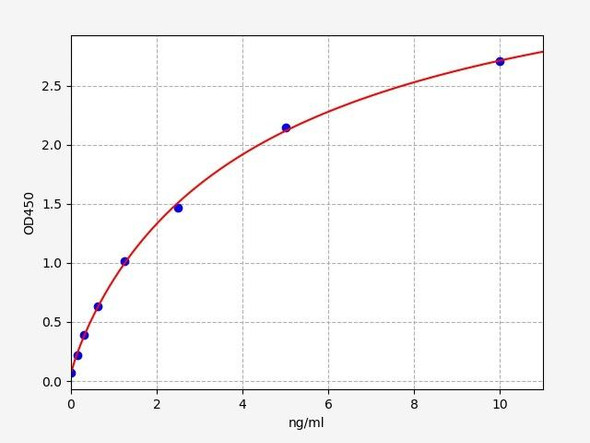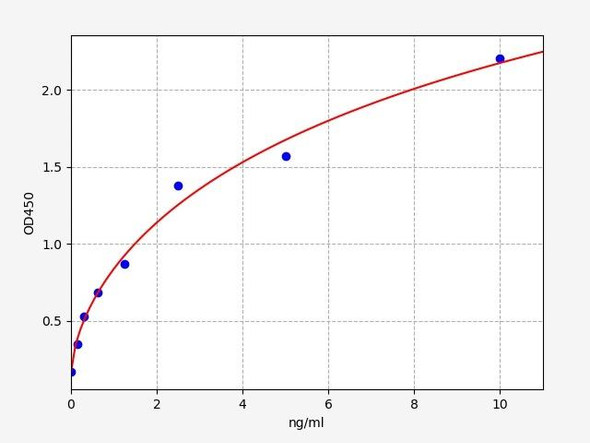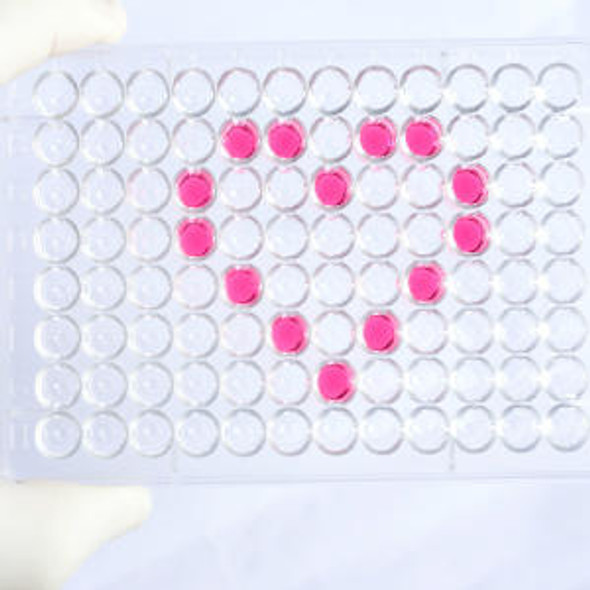Rat HIF-1 alpha / HIF1A ELISA Kit
- SKU:
- RTFI00112
- Product Type:
- ELISA Kit
- Size:
- 96 Assays
- Uniprot:
- O35800
- Sensitivity:
- 4.688pg/ml
- Range:
- 7.813-500pg/ml
- ELISA Type:
- Sandwich ELISA, Double Antibody
- Synonyms:
- HIF-1alpha, HIF1A, ARNT-interacting protein, Basic-helix-loop-helix-PAS protein MOP1, BHLHE78, Class E basic helix-loop-helix protein 78, HIF-1-alpha, HIF1-alpha, hypoxia-inducible factor 1-alpha, Member of PAS protein 1, member of PAS superfamily 1,
- Reactivity:
- Rat
Frequently bought together:
Description
| Product Name: | Rat HIF-1alpha (Hypoxia-inducible factor 1-alpha) ELISA Kit |
| Product Code: | RTFI00112 |
| Size: | 96 Assays |
| Target: | Rat HIF-1alpha |
| Alias: | HIF-1alpha, HIF1A, ARNT-interacting protein, Basic-helix-loop-helix-PAS protein MOP1, BHLHE78, Class E basic helix-loop-helix protein 78, HIF-1-alpha, HIF1-alpha, hypoxia-inducible factor 1-alpha, Member of PAS protein 1, member of PAS superfamily 1, PAS domain-containing protein 8 |
| Reactivity: | Rat |
| Detection Method: | Sandwich ELISA, Double Antibody |
| Sensitivity: | 4.688pg/ml |
| Range: | 7.813-500pg/ml |
| Storage: | 4°C for 6 months |
| Note: | For Research Use Only |
| Recovery: | Matrices listed below were spiked with certain level of Rat HIF-1alpha and the recovery rates were calculated by comparing the measured value to the expected amount of Rat HIF-1alpha in samples. | ||||||||||||||||
| |||||||||||||||||
| Linearity: | The linearity of the kit was assayed by testing samples spiked with appropriate concentration of Rat HIF-1alpha and their serial dilutions. The results were demonstrated by the percentage of calculated concentration to the expected. | ||||||||||||||||
| |||||||||||||||||
| Intra-Assay: | CV <8% | ||||||||||||||||
| Inter-Assay: | CV <10% |
| Uniprot: | O35800 |
| UniProt Protein Function: | Function: Functions as a master transcriptional regulator of the adaptive response to hypoxia. Under hypoxic conditions, activates the transcription of over 40 genes, including erythropoietin, glucose transporters, glycolytic enzymes, vascular endothelial growth factor, HILPDA, and other genes whose protein products increase oxygen delivery or facilitate metabolic adaptation to hypoxia. Plays an essential role in embryonic vascularization, tumor angiogenesis and pathophysiology of ischemic disease. Binds to core DNA sequence 5'-[AG]CGTG-3' within the hypoxia response element (HRE) of target gene promoters. Activation requires recruitment of transcriptional coactivators such as CREBPB and EP300. Activity is enhanced by interaction with both, NCOA1 or NCOA2. Interaction with redox regulatory protein APEX seems to activate CTAD and potentiates activation by NCOA1 and CREBBP. Involved in the axonal distribution and transport of mitochondria in neurons during hypoxia |
| NCBI Summary: | regulates transcription in response to low oxygen; may play a role in vascular biology [RGD, Feb 2006] |
| UniProt Code: | O35800 |
| NCBI GenInfo Identifier: | 13242249 |
| NCBI Gene ID: | 29560 |
| NCBI Accession: | NP_077335.1 |
| UniProt Secondary Accession: | O35800,Q9WTU9, |
| UniProt Related Accession: | O35800 |
| Molecular Weight: | 92,319 Da |
| NCBI Full Name: | hypoxia-inducible factor 1-alpha |
| NCBI Synonym Full Names: | hypoxia-inducible factor 1, alpha subunit (basic helix-loop-helix transcription factor) |
| NCBI Official Symbol: | Hif1a |
| NCBI Official Synonym Symbols: | MOP1 |
| NCBI Protein Information: | hypoxia-inducible factor 1-alpha; HIF1 alpha; HIF1-alpha; HIF-1 alpha; HIF-1-alpha; hypoxia-inducible factor 1 alpha; hypoxia inducible factor 1, alpha subunit |
| UniProt Protein Name: | Hypoxia-inducible factor 1-alpha |
| Protein Family: | Hypoxia-inducible factor |
| UniProt Gene Name: | Hif1a |
| UniProt Entry Name: | HIF1A_RAT |
| Step | Procedure |
| 1. | Set standard, test sample and control (zero) wells on the pre-coated plate respectively, and then, record their positions. It is recommended to measure each standard and sample in duplicate. Wash plate 2 times before adding standard, sample and control (zero) wells! |
| 2. | Aliquot 0.1ml standard solutions into the standard wells. |
| 3. | Add 0.1 ml of Sample / Standard dilution buffer into the control (zero) well. |
| 4. | Add 0.1 ml of properly diluted sample ( Human serum, plasma, tissue homogenates and other biological fluids.) into test sample wells. |
| 5. | Seal the plate with a cover and incubate at 37°C for 90 min. |
| 6. | Remove the cover and discard the plate content, clap the plate on the absorbent filter papers or other absorbent material. Do NOT let the wells completely dry at any time. Wash plate X2. |
| 7. | Add 0.1 ml of Biotin- detection antibody working solution into the above wells (standard, test sample & zero wells). Add the solution at the bottom of each well without touching the side wall. |
| 8. | Seal the plate with a cover and incubate at 37°C for 60 min. |
| 9. | Remove the cover, and wash plate 3 times with Wash buffer. Let wash buffer rest in wells for 1 min between each wash. |
| 10. | Add 0.1 ml of SABC working solution into each well, cover the plate and incubate at 37°C for 30 min. |
| 11. | Remove the cover and wash plate 5 times with Wash buffer, and each time let the wash buffer stay in the wells for 1-2 min. |
| 12. | Add 90 µL of TMB substrate into each well, cover the plate and incubate at 37°C in dark within 10-20 min. (Note: This incubation time is for reference use only, the optimal time should be determined by end user.) And the shades of blue can be seen in the first 3-4 wells (with most concentrated standard solutions), the other wells show no obvious color. |
| 13. | Add 50 µL of Stop solution into each well and mix thoroughly. The color changes into yellow immediately. |
| 14. | Read the O.D. absorbance at 450 nm in a microplate reader immediately after adding the stop solution. |
When carrying out an ELISA assay it is important to prepare your samples in order to achieve the best possible results. Below we have a list of procedures for the preparation of samples for different sample types.
| Sample Type | Protocol |
| Serum: | If using serum separator tubes, allow samples to clot for 30 minutes at room temperature. Centrifuge for 10 minutes at 1,000x g. Collect the serum fraction and assay promptly or aliquot and store the samples at -80°C. Avoid multiple freeze-thaw cycles. If serum separator tubes are not being used, allow samples to clotovernight at 2-8°C. Centrifuge for 10 minutes at 1,000x g. Removeserum and assay promptly or aliquot and store the samples at-80°C. Avoid multiple freeze-thaw cycles. |
| Plasma: | Collect plasma using EDTA or heparin as an anti-coagulant. Centrifuge samples at 4°C for 15 mins at 1000 — g within 30 mins of collection. Collect the plasma fraction and assay promptly or aliquot and store the samples at -80°C. Avoid multiple freeze-thaw cycles.Note: Over haemolysed samples are not suitable for use with this kit. |
| Urine & Cerebrospinal Fluid: | Collect the urine (mid-stream) in a sterile container, centrifuge for 20 mins at 2000-3000 rpm. Remove supernatant and assay immediately. If any precipitation is detected, repeat the centrifugation step. A similar protocol can be used for cerebrospinal fluid. |
| Cell Culture Supernatant: | Collect the cell culture media by pipette, followed by centrifugation at 4°C for 20 mins at 1500 rpm. Collect the clear supernatant and assay immediately. |
| Cell Lysates: | Solubilize cells in lysis buffer and allow to sit on ice for 30 minutes. Centrifuge tubes at 14,000 x g for 5 minutes to remove insoluble material. Aliquot the supernatant into a new tube and discard the remaining whole cell extract. Quantify total protein concentration using a total protein assay. Assay immediately or aliquot and store at ≤ -20°C. |
| Tissue Homogenates: | The preparation of tissue homogenates will vary depending upon tissue type. Rinse tissue with 1X PBS to remove excess blood & homogenizein 20ml of 1X PBS (including protease inhibitors) and store overnight at ≤ -20°C. Two freeze-thaw cycles are required to break the cell membranes. To further disrupt the cell membranes you can sonicate the samples. Centrifuge homogenates for 5 mins at 5000xg. Remove the supernatant and assay immediately or aliquot and store at -20°C or-80°C. |
| Tissue Lysates: | Rinse tissue with PBS, cut into 1-2 mm pieces, and homogenize with a tissue homogenizer in PBS. Add an equal volume of RIPA buffer containing protease inhibitors and lyse tissues at room temperature for 30 minutes with gentle agitation. Centrifuge to remove debris. Quantify total protein concentration using a total protein assay. Assay immediately or aliquot and store at ≤ -20 °C. |
| Breast Milk: | Collect milk samples and centrifuge at 10,000 x g for 60 min at 4°C. Aliquot the supernatant and assay. For long term use, store samples at -80°C. Minimize freeze/thaw cycles. |










